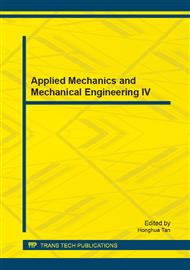[1]
H. S. Kim, J. B. Park, and Y. H. Joo, Stabilization of polynomial fuzzy large-scale system: Sum-of-square approach, Control, Automation and Systems (ICCAS), 2011 11th International Conference on, pp.1462-1466, (2011).
Google Scholar
[2]
T. Mori, Criteria for asymptotic stability of linear time delay systems, IEEE Trans. Automatic Control, vol. 30, pp.158-162, (1985).
DOI: 10.1109/tac.1985.1103901
Google Scholar
[3]
K. R. Lee, J. H. Kim, E. T. Jeung, and H. B. Park, Output feedback robust control of uncertain fuzzy dynamic systems with time-varying delay, IEEE Trans. Fuzzy Systems, vol. 8, pp.657-664, (2000).
DOI: 10.1109/91.890325
Google Scholar
[4]
K. Tanaka, T. Ikeda and H. O. Wang Robust Stabilization of a Class of Uncertain Nonlinear Systems via Fuzzy Control: Quadratic Stabilizability, Control Theory, and Linear Matrix Inequalities, IEEE Trans. on Fuzzy Systems, vol. 4, pp.1-13, (1996).
DOI: 10.1109/91.481840
Google Scholar
[5]
C. H. Sun and W. J. Wang, An improved stability criterion for T-S fuzzy discrete systems via vertex expression, IEEE Trans. Systems, Men, and Cybernetics-B, vol. 36, pp.672-678, (2006).
DOI: 10.1109/tsmcb.2005.860135
Google Scholar
[6]
K. Kiriakidis, Fuzzy model-based control of complex plants, IEEE Trans. Fuzzy Systems, vol. 6, pp.517-529, (1998).
DOI: 10.1109/91.728444
Google Scholar
[7]
C. S. Tseng and B. S. Chen, decentralized fuzzy model reference tracking control design for nonlinear interconnected systems, IEEE Trans. Fuzzy Systems, vol. 9, pp.795-809, (2001).
DOI: 10.1109/91.971729
Google Scholar
[8]
G. Leng, T. M. McGinnity and G. Prasad, Design for self-organizing fuzzy neural networks based on genetic algorithms, IEEE Trans. Fuzzy Systems, vol. 11, pp.57-67, (2003).
DOI: 10.1109/tfuzz.2006.877361
Google Scholar
[9]
R. L. Navale and R. M. Nelson, Use of genetic algorithms to develop an adaptive fuzzy logic controller for a cooling coil, Energy and Buildings, vol. 42, p.708–716, (2010).
DOI: 10.1016/j.enbuild.2009.11.010
Google Scholar
[10]
J. Sun, F. Zhao and L. Zhang, An improved genetic algorithm for the multi-echelon inventory problem of repairable spare parts, IEEE Trans. on Intelligent Computing and Intelligent Systems, Vol. 01, pp.440-444, (2010).
DOI: 10.1109/icicisys.2010.5658605
Google Scholar
[11]
F. H. F. Leung, H. K. Lam, S. H. Ling, and P. K. S. Tam, Tuning of the structure and parameters of a neural network using an improved genetic algorithm, IEEE Transactions on Neural Networks, vol. 14, p.79–88, (2003).
DOI: 10.1109/tnn.2002.804317
Google Scholar
[12]
F.H. Hsiao, S.D. Xu, C.Y. Lin and Z.R. Tsai, Robustness Design of Fuzzy Control for Nonlinear Multiple Time-Delay Large-scale Systems via Neural-Network-Based Approach, IEEE Trans. on Systems, Man, and Cybernetics-Part B, Vol. 38, pp.244-251, (2008).
DOI: 10.1109/tsmcb.2006.890304
Google Scholar
[13]
C. C. Sun, H. Y. Chung, and W. J. Chang, Design the T-S fuzzy controller for a class of T-S fuzzy models via genetic algorithm, IEEE Int. Conf. on Fuzzy Systems, vol. 1, pp.278-283, (2002).
DOI: 10.1109/fuzz.2002.1005000
Google Scholar
[14]
S. T. Pan, Evolutionary Computation on Programmable Robust IIR Filter Pole-Placement Design, IEEE Trans. Instrum. Meas., vol. 60, no. 4, p.1469–1479, Jan. (2011).
DOI: 10.1109/tim.2010.2086850
Google Scholar
[15]
Y.J. Sun, Exponential synchronization between two classes of chaotic systems, Chaos, Solitons & Fractals, vol. 39, pp.2363-2368, (2009).
DOI: 10.1016/j.chaos.2007.07.005
Google Scholar
[16]
D. Qi, M. Liu, M. Qiu and S. Zhang Exponential H∞ synchronization of general discrete-time chaotic neural networks with or without time delays, IEEE Trans. Neural Network, vol. 21, pp.1358-1365, (2010).
DOI: 10.1109/tnn.2010.2050904
Google Scholar
[17]
S. Boyd, L. E. Ghaoui, E. Feron, and V. Balakrishnan, Linear matrix inequalities in system and control theory, Philadelphia, PA: SIAM, vol. 15, (1994).
DOI: 10.1137/1.9781611970777
Google Scholar
[18]
P. Gahinet, A. Nemirovski, A. J. Laub, and M. Chilali, LMI control toolbox user's guide, The MathWorks, Inc., (1995).
Google Scholar


